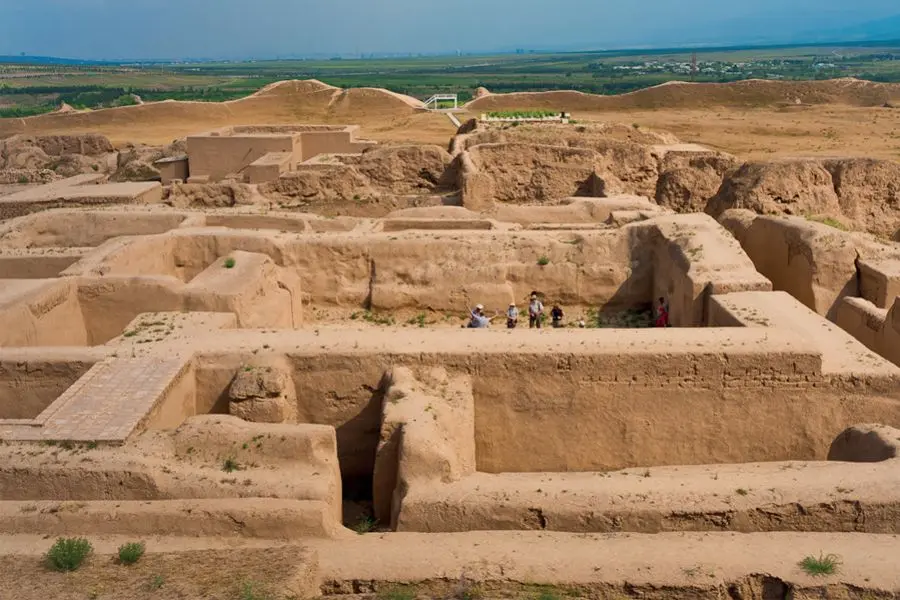

579

There are ancient ruins of Old and New Nisa, the legendary cities of antiquity 18 kilometers away from Ashgabat, at the foothills of the Kopetdag Mountains, in the picturesque valley of the Bagir village. The ruins of Old Nisa are remains of the center of the great Parthian kingdom, a once mighty and strong state, competing in the ancient world in military and economic power with Great Rome. Many Parthian cities and villages were located along the favourable trade routes of the Great Silk Road, the main of which was Nisa.
For quite a long period, Nisa was considered one of the richest and most prosperous cities in the East. This is evidenced by the travel notes of travellers. Medieval pilgrims, probably no less than today’s generation of tourists, craved for knowledge about the world around them. Being courageous and strong in spirit, overcoming the fear of the unknown, they went on distant journeys to see unexplored lands, breathe in their air, acquaint themselves with the peoples living there and be familiar with their original culture and way of life.
Speaking of Nisa, the Arab traveller and geographer al-Istakhri (850-934) noted that “in the tenth century, the city was half as big as Merv.” Another Arab traveller and historian al-Maqdisi (945-1000), who visited many Muslim cities of the East, compiled detailed reports on his stay in them, noted that “in Nisa there are 70 streets, enveloped in green gardens.” According to him, “Nisa is a vast and healthy city, abundant in water and material wealth; trees intertwine in it; the fruit are beautiful; the cathedral mosque is exquisite; the bread is delicious; the bazar is divided in rows where valuable and rare things can be met.” Besides, Arab sources greatly praised the numerous baths of Nisa, which were decorated with mural paintings. Nisa was called “the granary of Khorasan” by a number of other Arab travellers. Nisa’s heyday was in the XIth - XIIth centuries, when the city was part of the state of the Great Seljuks.
Foreign merchants and travellers, delegations of envoys who for the first time came along the routes of the Great Silk Road to Nisa, were astonished by hitherto unknown high and graceful, miraculous horses with dignity, that charmed the whole ancient world with their beauty. These tall horses, with the magnificent exterior, were called Parthian in ancient Rome, while in China, they were called heavenly. The well-known Russian historian A. Petrov notes, “The written evidence and ancient rock paintings survived show the undoubted need to identify this breed with modern Ahalteke horses, really beautiful creatures.”
The bazars of Nisa, full of a variety of local and imported goods, brought a large income to the city treasury in the form of payment for the rendering of various services and duties. There was a real frenzy of colour: from colourful tents, where they sold fresh meat, rice, flour, various fruit, melons and watermelons to exotic delicacies. The trade rows were abundant with glass, pottery and leather goods. Jewellery and fine arts were worthily represented. The unique products created by local craftsmen were in great demand among merchants from many cities of Asia and Europe.The bazars of Nisa formed the central place in the city, where people from different countries learned about the townspeople, their culture, interesting sights, traditions and customs. There people could play chess, listen to music and poems of poets, and from foreign merchants one could hear various amazing stories about wonderful distant journeys. The famous Parthian carpets, which merchants from Eastern and European cities were happy to buy, were in special demand at the Nisa bazars. The development of commodity-money relations contributed to the fact that Nisa became one of the recognised economic centres in the East. The city was well known along all the routes of the Great Silk Road.
In the Middle Ages, magnificent fabrics made of silk, wool and flax, made by craftsmen of Nisa, were in demand along various branches of the Great Silk Road, they were also exported to Asia Minor, Iran, Egypt and European countries. In the VIIIth-IXth centuries, ceramic art was at its zenith in Nisa. They produced beautiful multilitre amphorae, enamelled jars for storing grain, glazed jars for storing food; wine and water, though plates were covered with coloured enamel with an inscription, “Long life to the owner of this plate.” So, in ancient times there were marketers for advertising and selling goods.
Nisa became one of the main bridges in the history of the Great Silk Road, due to which many cities established mutually beneficial relations among each other. Running through Nisa and further, the transcontinental route led to the Mediterranean ports, and it is not accidental that the President of Turkmenistan in his literary work singles out the role and place of Nisa in the history of the Great Silk Road development.
Many centuries have passed, everything has dissolved in time, there is no such a legendary city for a long time, but unique works of art and architecture of Hellenistic culture, found by archaeologists in its place, are witnesses to the former greatness of Nisa and its great glory. The cultural and historical value of Nisa’s monuments is confirmed by the inscription of the ancient fortress on the UNESCO World Heritage List in 2007.